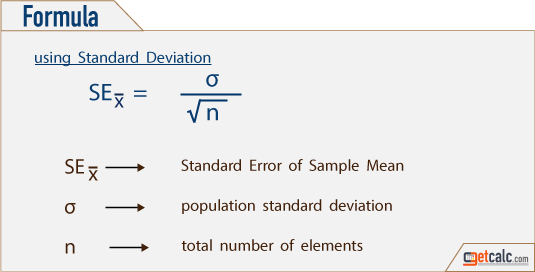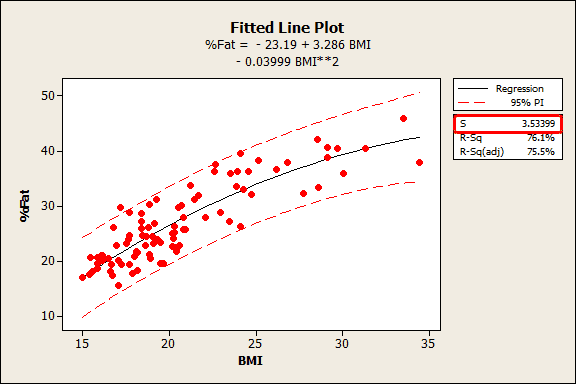
For quick calculations & reference, users may use this SE calculator to estimate or generate the complete work with steps for SE of sample mean (x̄), SE of sample proportion (p), difference between two sample means (x̄ 1 - x̄ 2) & difference between two sample proportions (p 1 - p 2). It's a statistic measure calculated from the sampling distributions where the large size samples or proportions reduces the SE of a statistic proportionally and vice versa. Setup the test of significance or hypothesis for large & small sample size (student's t & Z statistic) to measure the reliability of sample & population parameter and the estimation the confidence interval for population parameter are some of the major applications of standard error. I have calculated regression parameters using deming regression with the mcreg package: dem.reg <- mcreg(x, y, method.reg'Deming') printSummary(dem. Take each value in the fourth column and square it by multiplying it by itself. In the fourth column of your data table, you will calculate and record. Calculate the error of each predicted value.
CALCULATE STANDARD ERROR OF THE ESTIMATE DOWNLOAD
It is one of an important & most frequently used functions in statistics & probability. Performing the Calculations Download Article 1. In other words, it's a numerical value that represents standard deviation of the sampling distribution of a statistic for sample mean x̄ or proportion p, difference between two sample means (x̄ 1 - x̄ 2) or proportions (p 1 - p 2) (using either standard deviation or p value) in statistical surveys & experiments. It shows how effective the selected sample size n is in the statistical experiments or the reliability of experiment results with respect to the sample size. Calculate the standard error of the mean for a sample size of 49. Example: Assume the population standard deviation is 36.
/GettyImages-523109060-44bba8de80044d499afcc6a9e2bb5829.jpg)
So this is the final answer for depart.In probability & statistics, the standard deviation of sampling distribution of a statistic is called as Standard Error often abbreviated as SE. The Standard Error Calculator uses the following formula: SE x s / sqrt( n ) Where: SE x is the standard error of the mean, s is the standard deviation of the sample, sqrt is the square root, n is the sample size.
CALCULATE STANDARD ERROR OF THE ESTIMATE PLUS
Here we have 6.55 Plus -0.8 Shaving so this is equals to 6.55 minus 0.87 and 6.55 plus 0.87 and this is equals to 5.68 comma 7.42. Mean which we denoted by expert plus minus the margin error. So the formula for this is given by The sample. In deep part we have to find the 95% confidence interval. On solving this is equal to 0.870 point 87 Which is the final answer for C part. Multiplied with 1.1489 and is divided by under root 20. We can denoted by sigma also and divided by under routine which is equal to 2.93. And this multi this is equals to here we have value T critical, I will write it again clearly this is T critical. Is equals to T multiplied web as divided by under root N. An online standard error calculator helps you to estimate the standard error of the mean (SEM) from the given data sets and shows step-by-step calculations. And the critic critical value for this given data is equal to 2.093.

So alpha is equal to 0.05 DF is equal to N -1 which comes out to be 19. In c part we have to find margin of arrow 4 95% confidence interval, confidence India will So let's start with the solution from here we have this alpha Is equal to 1 -0.95.

The sigma comes out to be 1.8489 Which is the final answer for B part in C part we have to find the margin of arrow. Standard Error is calculated using the formula given below Standard Error s / n Standard Error 1.14 / 5 Standard Error 0.51 Therefore, the standard error of the sample mean is 0.51. Example: A sample population of 25 people was selected from a population of 100 people. Now putting all the values here here the X bar is me. The formula for standard deviation is this is denoted by sigma is equal to enter root summation X I minus x bar I is from one to n divided by a minus one. In be part we have to find the standard deviation standard deviation. And on putting all the values here and adding all the values and dividing it by 20 we get temple mean as for 6.55 So this is the answer for me. So the formula for mean is equals to summation Sigma I where I is from one to N and divided by N.

We are going to solve the question in this question we are given the data and in a part we have to find the meaning of this given death. The standard error of the mean, also known as the standard deviation of the mean, helps to determine the differences between more than one sample of information.


 0 kommentar(er)
0 kommentar(er)
